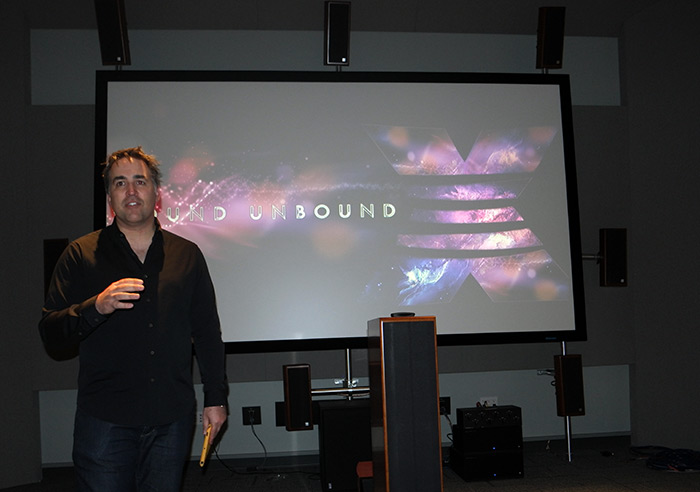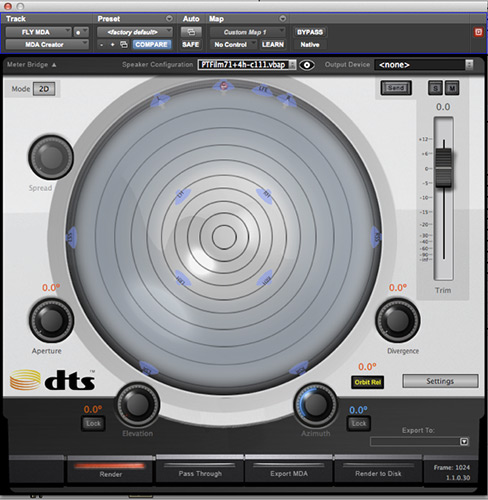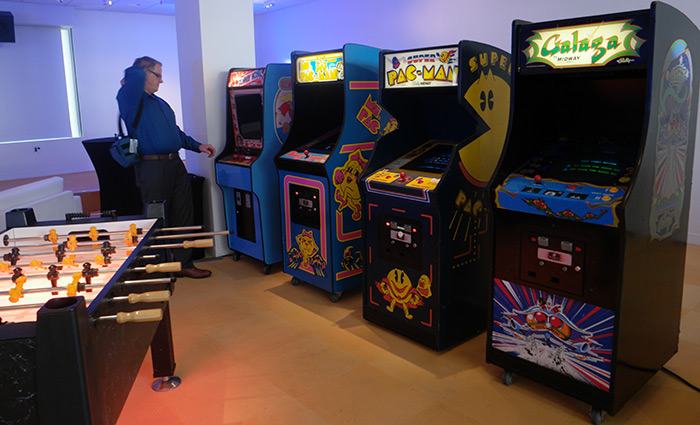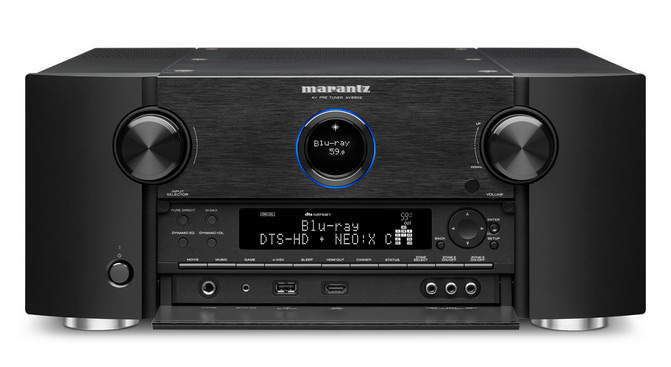At the official launch event for DTS:X at DTS headquarters in Calabasas, California yesterday, the company shared details of how its object-oriented immersive sound format will makes its way to homes - as well as theaters - through its partnerships in the consumer electronics and theatrical markets. "Immersive sound" is a term that describes a number of different surround sound formats which use height information to create a more three dimensional, more immersive surround sound mix. Dolby Atmos, launched in theaters in 2012 and available in select home theater products today is one such immersive sound format. AURO-3D is another. DTS:X will join these in home products beginning later this year.
We shared some details of the official announcement yesterday, but found out more at the launch event itself. One of the big questions about DTS:X is where will the content come from? Dolby Atmos has been included in or announced for for over 250 theatrical titles, but DTS effectively got out of the theatrical market with the sale of its theatrical business to Datasat several years ago. So where will the DTS:X source content come from that will eventually be delivered to the home market? Well it looks like DTS is getting back into theaters, albeit in a slightly different way.

In the past, DTS not only handled the codecs used in theatrical releases but also built the theatrical surround sound processors and had a team of installers and engineers who deployed DTS surround systems in theaters worldwide. Now DTS is working on getting back into theaters by offering studios a rotalty-free immersive sound content authoring tool - "MDA Creator" - and then partnering with theatrical distribution companies and theater owners to get the DTS immersive surround format into theaters.

In Asia, GDC Technology is promising a DTS MDA/DTS:X update to be made available to over 40,000 digital cinema servers beginning in May. They've also committed to building out over 350 DTS:X-certified cinema screening rooms starting at the same time. In the US, theater chain CarMike Cinemas has announced that it will build out eight screening rooms in select markets with DTS:X capability, beginning this spring. If all goes as planned, a large number of theaters worldwide will have the capability of playing back a movie in DTS:X immersive surround.
If They Build Them, Will They Come?
Planning DTS:X-capable cinemas is all well and good, but what will they play on them? DTS says it is in talks with several studios and content authoring houses in Canada, Southern California and Northern California, ("Hey, Isn't Lucasfilm in Northern California?" I asked myself) in order to explore the opportunities for DTS MDA and DTS:X to be used in upcoming films. Yesterday we learned that Marvel Studios is using DTS MDA Creator as the immersive surround authoring tool for the IMAX release of a little movie called "The Avengers: Age of Ultron." And while the output of this mix will be a proprietary 12-channel IMAX immersive sound mix (not DTS:X), it is encouraging to see that the authoring tool itself is beginning to be adopted in the industry. DTS MDA creator is capable of rendering its object-based sound mixes into a number of different immersive audio formats.

So what about the 200+ movies already encoded in Dolby Atmos for theaters? According to DTS Senior Director of Strategy and Marketing, Dave Casey, "Once a movie is mastered in an immersive sound format, it's fairly easy to output that in a different immersive sound format." So while DTS stopped short of offering any details of a Dolby Atmos-to-DTS:X conversion tool, it seems that most of the heavy lifting involved in creating an immersive soundtrack can be leveraged when converting or rendering that soundtrack to a different immersive format. In support of that, one thing I noticed on the DTS:X demo disc from CES 2015 was that they included a DTS:X demo clip from "Rio 2," a film that was relased in theaters in Dolby Atmos. So there doesn't appear to be anything stopping DTS from convincing the studios to release Dolby Atmos theatrical titles in DTS:X for their home release.
Until the content starts flowing, DTS:X customers will need to satisfy their height-enhanced sound craving with regular 5.1 and 7.1 content that is "upmixed" into an immersive sound mix by DTS Neural:X. Just as Dolby has a featured simply called "Dolby Surround" which can add height information to non-height-encoded content, so does DTS include Neural:X as a core feature of the DTS:X surround sound suite. DTS Neural:X is the latest version of what was previously known as Neo:X (DTS does seem to have some issues sticking to one name, but I digress...)
DTS Neural:X uses cues detected in the standard 5.1 and 7.1 surround content to create a more immersive surround experience. We heard a demo of this with a clip from "Rise of the Planet of the Apes" and it did have a more wide open sound when played back in Neural:X as opposed to standard 7.1 surround. Wind and other ambient sounds floated down from the trees and ape howls resonated from above. But it's important to note that this synthesized height enhancement is only a pale shadow of what you get from real DTS:X-encoded content.
Also, one benefit of DTS:X encoded content, which differs from anything we've seen in immersive sound before, is the ability to independently raise or lower dialog within a soundtrack. Because the dialog track (or tracks) can be stored as separate objects, it is theoretically possible to adjust this during playback, without affecting other parts of the mix. I say "theoretically" because enabling this feature is entirely up to the content creators (the studios). And we're not sure how directors and professional sound mixers will feel about giving away artistic control of their film soundtracks. So while this feature might be something consumers are interested in, we would be a bit surprised to see a lot of titles with this feature enabled.
In order for consumers to bring the DTS:X immersive experience home, DTS is partnering with several consumer electronics manufacturers to build DTS:X decoders into receivers and preamp/processors coming later this year. Three products already on the market (a Denon receiver and two preamp/processors from Marantz and Trinnov Audio) will get DTS:X via firmware upgrades. Several other electronics companies have pledged support for DTS:X with specific model announcements to follow later this year. You can find out more about specific brands and models in our earlier coverage.

Speaker Makers Are Gonna Love This
So you'll need a new receiver, and hopefully the content will come soon with announcements directly from the studios. But what about the speakers? In order to get truly immersive, you'll need to install speakers in your ceiling or mounted high on a wall to reproduce the height dimension and map sounds into 3D space. DTS says the home implementation of DTS:X will support up to 32 independent speakers, though the first batch of receivers and processors is expected to max out at 11 channels (7.1 surround plus 4 height speakers). You can also get by with as few as five traditional surround speakers and a subwoofer (5.1) plus two height channels, but the effect will improve with more speakers.
There was some speculation earlier this year that DTS might support height channels via virtualization. In other words, height information would be "virtualized" using a standard 5.1 or 7.1-channel surround sound system (with no need to mount speakers on the ceiling). But Mr. Casey told us that this height virtualization feature is not planned for the initial rollout of DTS:X. "We do want to be format agnostic, however. So if a customer has already installed speakers for a different immersive surround technology, they will work fine for DTS:X thanks to our advanced speaker remapping engine." When asked if DTS:X could work with the upward-firing Dolby Atmos "elevation modules" which bounce sound off the ceiling in order to make it sound like it is coming from above, Mr. Casey said, "there's nothing in our system to prevent that from working." He did stress, however, that it's up to the individual receiver or processor manufacturer to decide whether they would allow this type of configuration.
Another feature we heard demonstrated at the event was DTS Headphone:X. We've heard this before and it is really impressive. DTS Headphone:X simulates an 11.1 surround sound experience within a standard 2-channel pair of headphones. This content works even better with a discrete multi-channel DTS:X source. While DTS Headphone:X is technically part of the DTS:X suite, it is optional. So not all DTS:X-enabled products will necessarily offer DTS Headphone:X.
We're expecting more news and specific announcements to trickle out over the next few months but we have to say what we've seen (and heard!) so far is encouraging.
Related Articles: